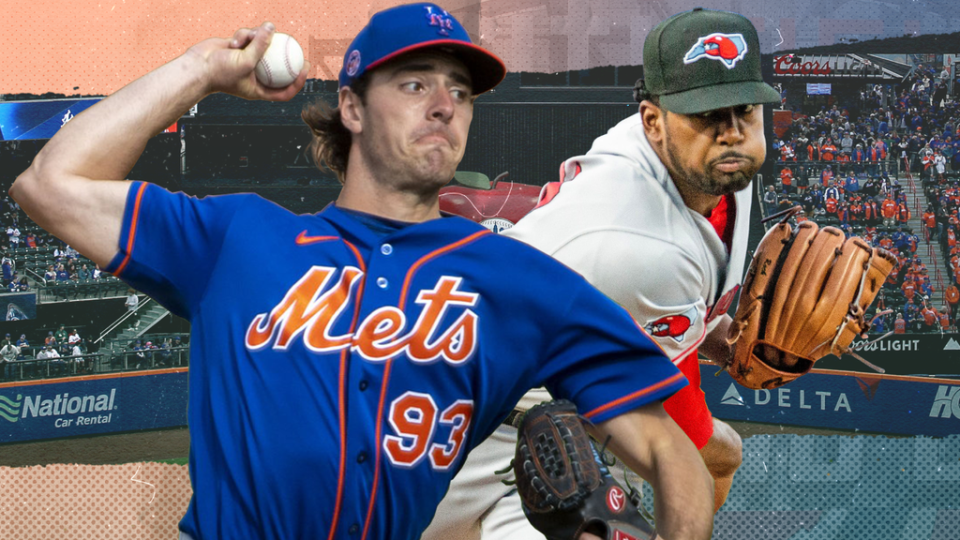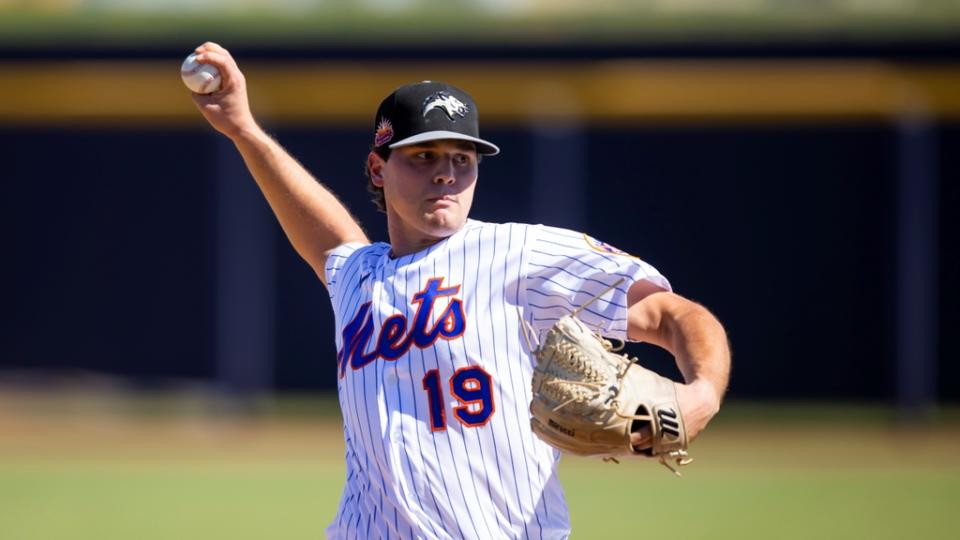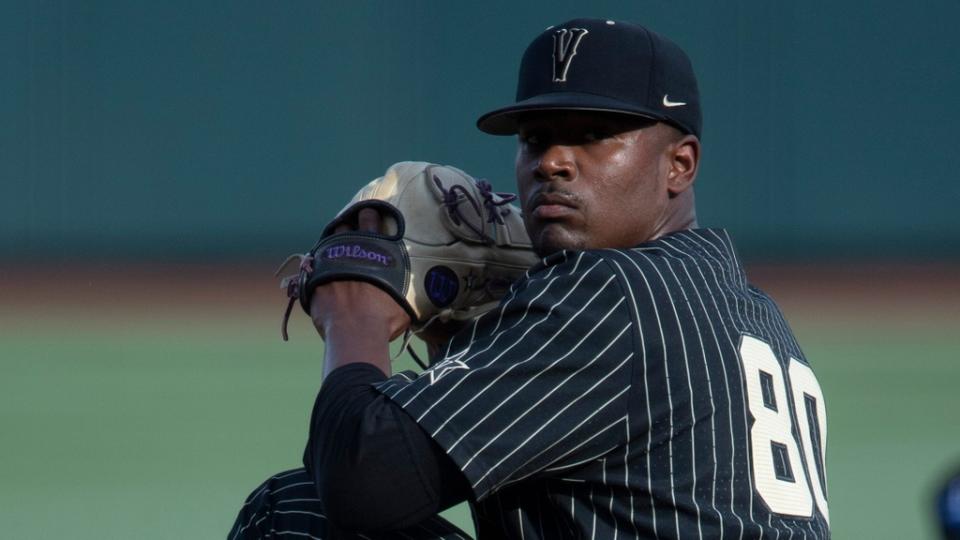What happened to all the Mets' young pitching?

The concerns about age, especially in the starting rotation, were significant before the Mets season began. They’re just a little more noteworthy two weeks in, due to injuries to Justin Verlander and Jose Quintana, as well as two poor starts from Carlos Carrasco and something less than the usual dominance from Max Scherzer to start off.
With that comes an obvious question: Where is the young pitching?
In David Peterson and Tylor Megill the Mets may have enough homegrown depth to weather the current injuries and performance drop-offs, but beyond those two, the organization boasts no blue-chip pitching prospects -- at least none deemed close to major league ready.
They’re loaded on the position-player side, something Mets fans know very well as they track the Triple-A at-bats of Brett Baty, Mark Vientos, and Ronny Mauricio, in addition to the recently promoted Francisco Alvarez.
But where are the pitchers? Since the 2009 and 2010 drafts that produced Steven Matz, Matt Harvey, and Jacob deGrom (they traded for Zack Wheeler and Noah Syndergaard, remember), the Mets have come up mostly empty in drafting quality pitching.
To be fair, they have reaped some benefits by trading pitchers they drafted: Justin Dunn was included in the Edwin Diaz trade; Simeon Woods Richardson and Anthony Kay were dealt for Marcus Stroman; Kevin Smith was moved for Miguel Castro; Josh Wolf was part of the Francisco Lindor and Carrasco trade; and J.T. Ginn was the key figure in the deal for Chris Bassitt a year ago.
Yet none of those starters have blossomed for their new teams, at least not yet.
Meanwhile, here are the other pitchers drafted by the Mets in the third round or higher, going back 10 years: Andrew Church, Casey Meisner, Max Wotell, Peterson, Matt Allan, Kumar Rocker, Calvin Ziegler, Dominic Hamel, Blade Tidwell, and Brandon Sproat.

I looked a little deeper as well, at pitchers selected in the 10th round or higher the last 10 years, but of those 29 draftees, the only notables were Megill, an eighth-round selection in 2018, and perhaps Mike Vasil, an eighth-round pick in 2021 out of the University of Virginia that some scouts see as a potential blue-chipper.
(As an interesting side note, the Mets took a couple of current big-league starters that they didn’t sign coming out of high school: 26th-rounder Shane McClanahan in 2015 and 32nd-rounder George Kirby in 2016).
So what’s it all mean?
Obviously, the Mets haven’t drafted enough quality pitching over the last several years. And the same can be said for their international signings. But also to be fair, injuries and circumstances have to be considered.
Specifically, if Allan had stayed healthy and Rocker’s physical hadn’t convinced the Mets not to sign him, they might be able to boast of three high-ceiling starters closing in on Queens.
As it is, Tidwell is the only one of those three who offers that type of hope. A second-round selection out of the University of Tennessee last year, the right-hander was considered a first-round talent who slipped in the draft because he missed some time during his final college season with a shoulder injury.
“He has No. 1-type stuff and potential,” says a scout who saw him pitch several times for Tennessee. “But his command is a long way from being ready (for the big leagues).”
Tidwell has only thrown 13.2 innings as a professional, including four in his one rocky start for Brooklyn this season. Yet he’s the consensus highest-ranked pitching prospect for the Mets by most of the well-known prospect sites, a designation that is revealing about the organization’s overall state of pitching.
That wouldn’t be the case, of course, if Allan had avoided injury.
Remember, the Mets made a shrewd move to draft Allan in the third round of the 2019 draft. After grabbing Baty in the first round and Wolf in the second, they saw that Allan, a high school pitcher committed to Florida, had slipped out of the first round because agent Scott Boras scared off teams by telling them it would take a $4 million bonus to sign him.
Partly because they had scouted him extensively and gotten to know Allan personally, the Mets were convinced he didn’t really want to go to college and would accept a lesser bonus. They turned out to be right, getting him to sign for $2.5 million, but to be able to use that much from their draft allotment, they had to draft fourth-year seniors with no leverage over their next several picks, committing just $62,000 in bonuses on their next seven players selected.
“It was a smart play,” says MLBPipeline.com analyst Jim Callis. “It’s worth taking those lesser picks to get a potential first-rounder. It’s just that Allan has been hurt. That’s always the gamble with drafting pitching.”
Allan, in fact, has had multiple issues with his elbow, needing two Tommy John surgeries, the most recent in this last offseason, as well as a nerve transposition procedure, making his future uncertain.
“We loved his arm and his makeup,” one Mets person told me. “It’s a shame, really.”
And then there’s Rocker. The Mets drafted the former Vanderbilt star with the 10th overall pick in 2021 but never made him an offer to sign, because they were scared off by the results of his physical.
Rocker wound up having shoulder surgery later that year but recovered well enough for the Texas Rangers to draft him with the third overall pick in last year’s draft.
And for what it’s worth, the right-hander was impressive in his minor league debut earlier this week in a High-A start, needing only 53 pitches to throw five scoreless innings and rack up eight strikeouts.
That’s a long way from the big leagues, but it will be intriguing to follow Rocker’s progress. The shoulder surgery in 2021 would seem to validate the Mets’ decision not to sign him, yet on the other hand, the $5-6 million or so it would have cost them for his bonus is nothing compared to what they’ve had to pay for pitching on the free agent market.

In any case, the details of drafting Rocker still are somewhat fuzzy. Mets people avoid the subject, but word among opposing scouts and evaluators, as I heard it this week, is that the decision to take him was dictated by Steve Cohen’s then newly beefed-up analytics department, which is reasonable to believe considering how much influence those analysts had in all phases of the organization in 2021, notably driving Mets hitters crazy by overloading them with information in daily meetings.
In any case, it’s not clear whether the Mets' scouting department wanted Rocker with that No. 10 pick. It’s also worth noting that three picks later, the Phillies selected Andrew Painter, then a high school kid who is now ranked as a Top 5 prospect in all of baseball, though he’s dealing with a sprained UCL.
“Their scouts liked Rocker,” says a scout from a rival organization. “Everybody did. He had a dip in his velocity but you see that with a lot of college kids who are overworked. (Jack) Leiter’s velocity was up and down that year. There was speculation about Rocker but nobody knew anything for sure. He didn’t do the pre-draft MRI. It was a matter of what you were willing to take a chance on once he had the physical.”
A year later, after shoulder surgery, the Rangers were convinced that Rocker could get back to being the guy who was once considered the best pitcher in college baseball. Opinions around baseball are in agreement there’s just no way to know yet.
“I saw him in the (Arizona) Fall League and I thought they’d made a mistake,” says one scout of the Rangers’ decision. “His velocity was in the mid-90s but he wasn’t throwing the ball by anyone. His arm slot was lower and he was having control problems. But I’ve heard he’s looked a lot better this spring, so maybe he just needed time.”
We’ll see. Maybe the Mets will regret not signing Rocker, though more than one scout/evaluator pointed out they may be better off with Kevin Parada, the Georgia Tech catcher they took with the 11th pick last year -- the compensation pick for not signing Rocker.
“Parada should have gone higher,’’ one scout said. “He slid because of his asking price. He’s going to be a really good major league hitter.”
Even in that case, it remains to be seen how the Mets will fill the need for young pitching. Perhaps they can trade from their surplus of top position player prospects for pitching, and there’s always a chance that blue-chippers, starting with Tidwell, will emerge in their system.
But to the question of why they haven’t drafted as well on the pitching side, people in the industry chalk it up mostly to the difficulty for any organization to draft and develop young pitching.
“It’s the hardest thing to do,” says J.P. Ricciardi, the former Mets assistant GM who is now in the San Francisco Giants front office. “Drafting pitching is a crapshoot. So many kids get hurt.
“I don’t think the Mets are doing anything different from anybody else. They have good people doing their scouting. I don’t think they’re doing anything wrong. Sometimes you have to get lucky with pitching.”
The problem is the Mets haven’t been lucky for a while. They are fortunate to have an owner willing to pay top dollar for free-agent pitching, but as we’re seeing now, age usually is part of that equation.
How much more age and injury are an issue in 2023 remains to be seen. But Cohen has made it clear he wants to build a sustainable, LA Dodgers-like winning organization that eventually won’t necessitate a record-breaking payroll, and to accomplish such a task will certainly mean doing a better job of drafting and developing young pitching.

